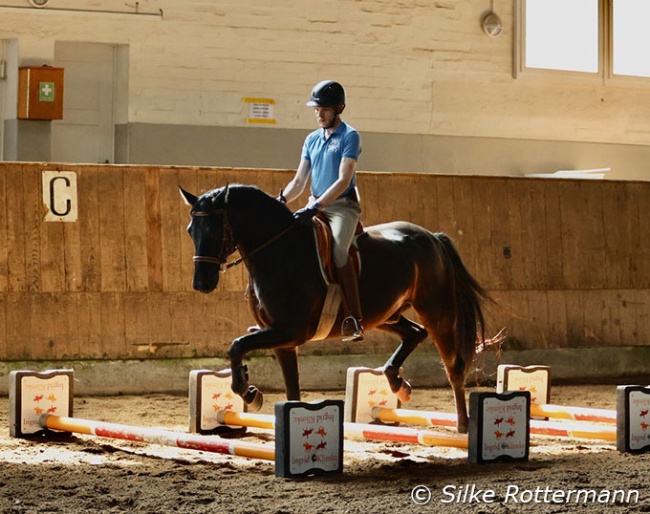
-- by Max Jaquerod, edited by Silke Rottermann
How many dressage horses hardly get over an obedience fence, have never seen cavaletti, or are allowed to hack to move in an unconstraint day? I claim that many leg troubles originate from the fact that way too early horses get a specialized training.“
These words might sound very recent, but they are more than four decades old. vThe late Dr. Reiner Klimke wrote them in the foreword to his book „Basic Training of the Young Riding Horse," first published in 1980.
Nowadays his daughter Ingrid keeps the flag of versatile training flying and while it is undoubted that this kind of broad approach strengthens the horses physically and mentally, it is still not the norm in dressage.
From the beginning of his life as a riding horse Fanti has received a versatile training because he did not grow up in a competition stable focused on dressage. Until his 6th year of life he had been in the Swiss Army stables near Berne.
Long trail rides in groups over undulating terrain, jumping natural fences and in an arena was what he got used to during his army days. So we certainly had some advantages when I took over Fanti in the late spring of 2023, compared to if I had bought a horse at a specialized dressage training stable where the quick valorization of talented horses and not the more time consuming broad basic training is usually the clear focus.
Why I cannot afford and do not want to train 'only' dressage
I am a dressage rider by heart and this is what I enjoy most when riding: To develop my horse through useful gymnastic exercises and then feel how everything becomes easier and our communication more refined after some time.
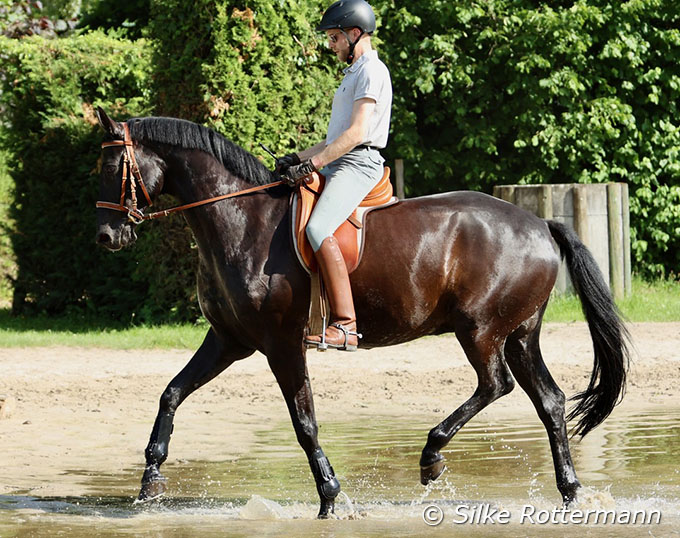
when trotting through water
Of course it would be possible to develop more push and increased elasticity entirely through dressage work in order to create better impulsion, but I also want to keep Fanti motivated and mentally interested in his work because it does not come on its own for him. I also aim to have a horse that feels safe between A and C and therefore gives a comfortable ride for me wherever we go, may it be the dressage arena, in traffic, at a show or at busy places.
For this reason I approached Fanti’s training from the beginning of our partnership in a holistic way. I use various ways to strengthen his hindquarters and further improve his rideability because „relaxation, rhythm and contact also need to be focused on while jumping, training over cavaletti or just hacking out," to quote Dr. Reiner Klimke in his book one more time.
Igniting the "Engine"
If you look at some foals at top foal auctions their hind-legs are already incredibly active. Fanti is not like that. After one of my first medium level classes in the spring of 2025 I showed a video of our ride to a retired German I-judge and she summed it up by saying „the engine needs to be more ignited and then the horse will be one you cannot overlook.“
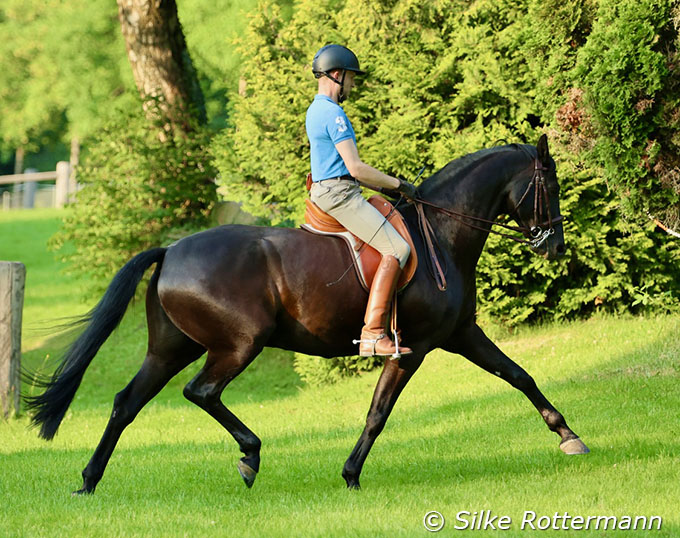
intensifies the required push-off
We often hear sentences like "he has to be quicker behind", "he has to step more under," or "he has to come more from behind." They all mean the same thing, but what is really meant? More push from the hindquarters is not automatically more impulsion.
Push simply means the horse’s hind legs reach more under the body towards the centre of gravity, caused by a powerful push off and that can even be observed in wild horses or very young foals . Sufficient push though is the precondition of impulsion.
Impulsion after the German training scale means that this pushing power and a flexibility of the joints, shown in an increased carrying power, is the result of correct dressage work. It results in a suspension-like push off of the hind-legs. The horse proverbially then extends with raised withers, creating a forward-upward impression in the extensions. This definition can be completed by what impulsion means in French equitation that is: The ability of the horse to react to the slightest indication of the rider.
So a very important goal of Fanti’s training is to achieve both: To have a quicker and also a stronger response of his ‚engine‘. In the following I want to give you a general overview how a usual training week of Fanti looks like in which I try to increase his degree of impulsion, his rideability and keep him interested and motivated at the same time.
Cavaletti to Activate the Hind Legs
I admit before I got Fanti I never used cavaletti work in the weekly training and I never seriously dealt with this topic, but after the German judge’s verdict and her proposal to include cavaletti sequences I tackled it and I borrowed Klimke's cavaletti manual to dig into the topic.
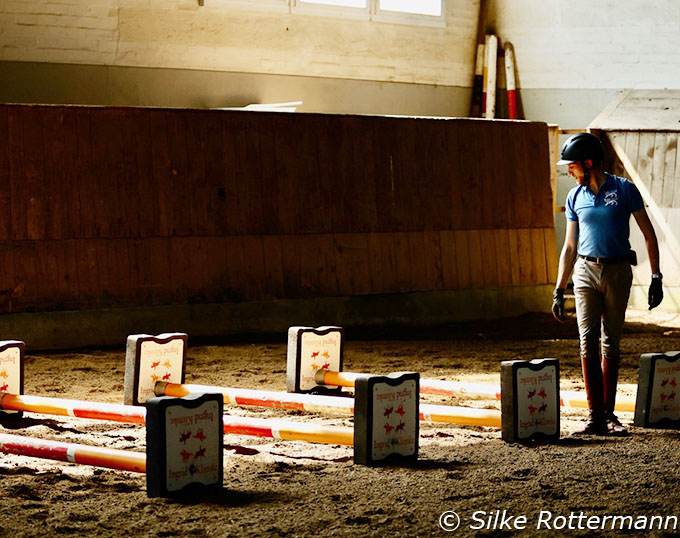
best at this stage of his cavaletti training
The aim is to animate Fanti to step higher and be generally more active in trot. It took only some attempts and I realized that he did not yet feel comfortable trotting over the height foreseen for this gait. So we reduced the height to the one for walk where he felt much more comfortable trotting over and as a result did not struggle getting into a nice rhythm which is very important.
Since then I regularly include a sequence of four cavaletti at the short side of the arena in my usual dressage training and practice them several times on both hands during a lesson, but I do not exaggerate it. It is important Fanti feels fresh and supple when tackling the cavaletti.
Fanti reacted very positively to the cavaletti exercises once he understood what to do and it is amazing to feel the rhythm and action he develops over the poles, thereby giving his back. He now knows exactly what he needs to do and gets into the "cavaletti mode" once I point him at them.
However, it was paramount to make him clear that work is not over once the last raised pole is passed, but to take care to ride him forward after the cavaletti sequence in order to maintain the action he developed over the poles.
Working Outside the Dressage Boards
The National Horse Centre in Berne has the fantastic opportunity to have what we Bernese call the "paddock" which is a green oasis in Berne…a property nearby the stable complex with a sandy race-track running around it and a huge variety of cross-country fences of different levels, billboards to jump on and off, ditches, a wall and an artificial bridge to cross.
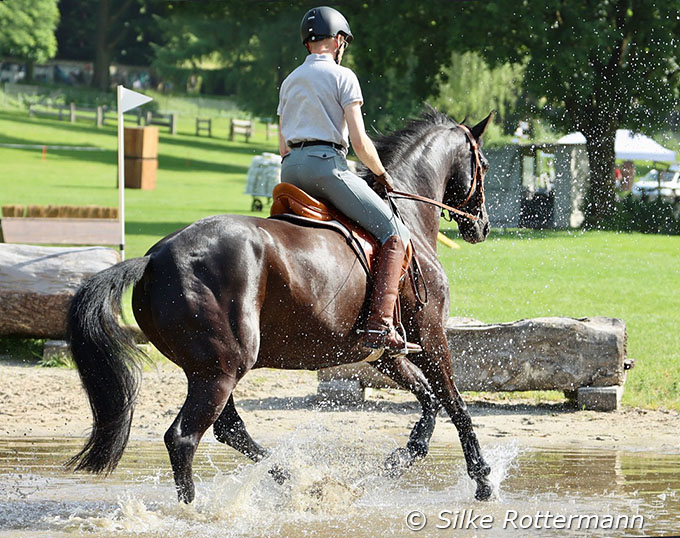
on a hot summer day.
Here in the "paddock"Fanti has to deal with an undulating ground as the area in parts is slightly uphill and then downhill again, with a lot going on at the same time: People walking their dogs, other horses cantering around at high speed, joggers and bikers never far away. It is a nice test to see if the horse can completely focus on me under such conditions, but also pay attention to the ground he is going over.

helps schooling balance and self-carriage
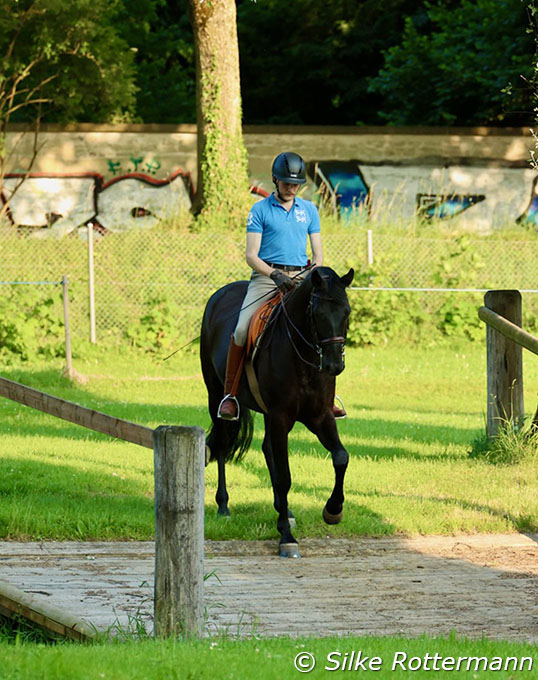
So the dressage training outside the arena boards has its own challenges, but as Fanti trusts me he learns to come back to me very quickly again after a distraction and gets used to many different things which might also be part of a show.
Cross-Country Fences For A Dressage Horse

the balance and seems fun for Fanti.
Fanti is not the most talented jumper, even though at the very beginning of his career as a riding horse he even started in some jumping classes at novice level with his previous rider. My horse has a big heart and he is very rideable which means I can easily adjust his strides to make distances to fences fit. So Fanti has learnt to jump confidently over every terrain and type of fixed fence we put him in front of and he seems to thoroughly enjoy his trips to the cross-country track.
He loves to fly ditches or jump into water, splashing through it and go staircase-like fences up and down. Thanks to his rideability which we have achieved through proper dressage work it is a pure joy and in turn gives me a lot of safety to approach fences in his lovely rhythm which can be so easily controlled. He also does not bat an eyelid walking, trotting or cantering over wooden bridges with the noise that comes from 600 kilogram passing over.
He confidently climbs the steep wall in the paddock and is now nicely balanced coming down again, with his hind-legs deeply under his body to handle the descent safely.
Fanti Is Fun
Fanti and I are now together for about two years. As he is so different in many ways than the mare I had before he has developed me as much as a rider as I have developed him as a dressage horse.

and comfortable ride, even in the traffic of Switzerland’s capital.
As Fanti is now well established in the medium level movements and places consistently at this level at dressage shows, we already refine and improve movements for the advanced level, such as flying changes in series, pirouettes or advancing from half steps to piaffe. However, my goal has always been and will always remain to achieve all this without breaking my horse’s spirit or on the expense of his health which both have top priority.
At the end I want to quote the great Chris Bartle, 6th at the 1984 Olympic Games in dressage and Badminton winner in 1997. He had a versatile approach of his dressage horses’ training. He stressed in Jane Kidd’s book „Goodwood Dressage Champions“ that he looks at the whole, the lightness and ease of a pair’s performance and that this is more important to him than anything else. I can only underline these words as they mirror perfectly which is also my aim.
I am going to report about the challenges we face here in one of the next parts of this series.
Photos © Silke Rottermann
Related Link
Fanti's Progress - Part I: What Good Dressage Training Can Do to a Horse
Fanti's Progress - Part II: "The Rider Must Control Himself Before He Can Control His Horse"
Fanti's Progress - Part III: "Taking a Step Up While Refining the Basics"
Fanti's Progress - Part IV: A Three-Day Training Stint with Anja Beran
Fanti's Progress - Part V - Why Compete Today if You Want to Be a Classical Dressage Rider?
Fanti's Progress - Part VI: Rediscovering the Love for Dressage Through Fanti